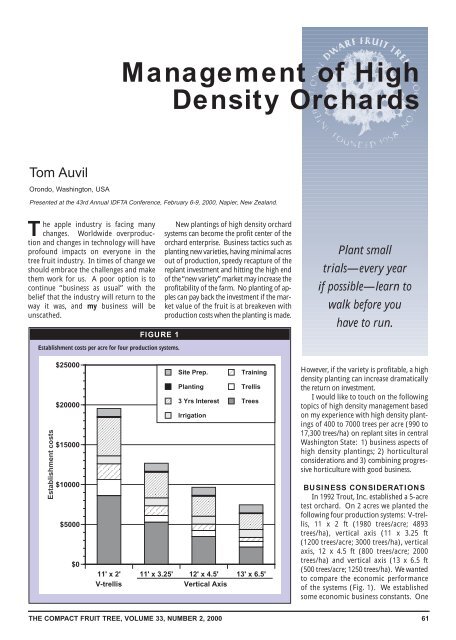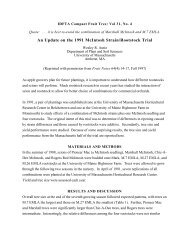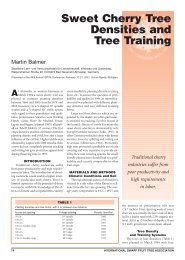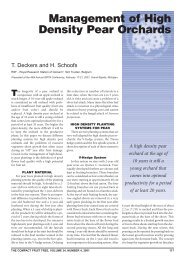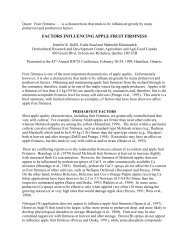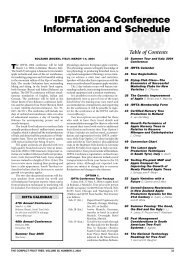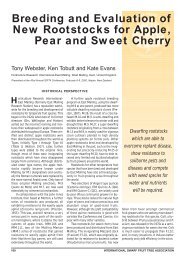Management of High Density Orchards - Virtual Orchard
Management of High Density Orchards - Virtual Orchard
Management of High Density Orchards - Virtual Orchard
Create successful ePaper yourself
Turn your PDF publications into a flip-book with our unique Google optimized e-Paper software.
<strong>Management</strong> <strong>of</strong> <strong>High</strong><br />
<strong>Density</strong> <strong><strong>Orchard</strong>s</strong><br />
Tom Auvil<br />
Orondo, Washington, USA<br />
Presented at the 43rd Annual IDFTA Conference, February 6-9, 2000, Napier, New Zealand.<br />
The apple industry is facing many<br />
changes. Worldwide overproduction<br />
and changes in technology will have<br />
pr<strong>of</strong>ound impacts on everyone in the<br />
tree fruit industry. In times <strong>of</strong> change we<br />
should embrace the challenges and make<br />
them work for us. A poor option is to<br />
continue “business as usual” with the<br />
belief that the industry will return to the<br />
way it was, and my business will be<br />
unscathed.<br />
FIGURE 1<br />
New plantings <strong>of</strong> high density orchard<br />
systems can become the pr<strong>of</strong>it center <strong>of</strong> the<br />
orchard enterprise. Business tactics such as<br />
planting new varieties, having minimal acres<br />
out <strong>of</strong> production, speedy recapture <strong>of</strong> the<br />
replant investment and hitting the high end<br />
<strong>of</strong> the “new variety” market may increase the<br />
pr<strong>of</strong>itability <strong>of</strong> the farm. No planting <strong>of</strong> apples<br />
can pay back the investment if the market<br />
value <strong>of</strong> the fruit is at breakeven with<br />
production costs when the planting is made.<br />
Plant small<br />
trials—every year<br />
if possible—learn to<br />
walk before you<br />
have to run.<br />
Establishment costs per acre for four production systems.<br />
Establishment costs<br />
$25000<br />
$20000<br />
$15000<br />
$10000<br />
$5000<br />
$0<br />
Site Prep.<br />
Training<br />
Planting<br />
Trellis<br />
3 Yrs Interest Trees<br />
Irrigation<br />
11' x 2' 11' x 3.25' 12' x 4.5' 13' x 6.5'<br />
V-trellis<br />
Vertical Axis<br />
However, if the variety is pr<strong>of</strong>itable, a high<br />
density planting can increase dramatically<br />
the return on investment.<br />
I would like to touch on the following<br />
topics <strong>of</strong> high density management based<br />
on my experience with high density plantings<br />
<strong>of</strong> 400 to 7000 trees per acre (990 to<br />
17,300 trees/ha) on replant sites in central<br />
Washington State: 1) business aspects <strong>of</strong><br />
high density plantings; 2) horticultural<br />
considerations and 3) combining progressive<br />
horticulture with good business.<br />
BUSINESS CONSIDERATIONS<br />
In 1992 Trout, Inc. established a 5-acre<br />
test orchard. On 2 acres we planted the<br />
following four production systems: V-trellis,<br />
11 x 2 ft (1980 trees/acre; 4893<br />
trees/ha), vertical axis (11 x 3.25 ft<br />
(1200 trees/acre; 3000 trees/ha), vertical<br />
axis, 12 x 4.5 ft (800 trees/acre; 2000<br />
trees/ha) and vertical axis (13 x 6.5 ft<br />
(500 trees/acre; 1250 trees/ha). We wanted<br />
to compare the economic performance<br />
<strong>of</strong> the systems (Fig. 1). We established<br />
some economic business constants. One<br />
THE COMPACT FRUIT TREE, VOLUME 33, NUMBER 2, 2000<br />
61
constant is the make up <strong>of</strong> variable and<br />
fixed costs. We have found that in the Lake<br />
Chelan area <strong>of</strong> Washington State most<br />
farms are small, averaging about 40 acres.<br />
We found that the fixed costs <strong>of</strong> the<br />
business are about $3000 per acre. We<br />
FIGURE 2<br />
added $25 ($1 per bushel per bin) in variable<br />
costs for each bin. We charged each<br />
system 10% annual interest on the establishment<br />
and production investments.<br />
NOTE: The interest for establishment<br />
costs for the first three seasons and the<br />
Relationship <strong>of</strong> four systems with varying tree density and fruit production during four seasons.<br />
Production (boxes/acre)<br />
5000<br />
4500<br />
4000<br />
3500<br />
3000<br />
2500<br />
2000<br />
1500<br />
1000<br />
500<br />
0<br />
11' x 2', V-trellis<br />
11' x 3.25', Vertical Axis<br />
12' x 4.5', Vertical Axis<br />
13' x 6.5', Vertical Axis<br />
1994 1995 1996 1997 Total<br />
FIGURE 3<br />
Per box cost <strong>of</strong> production during four seasons was directly tied to production level.<br />
Cost/box<br />
$16.00<br />
$14.00<br />
$12.00<br />
$10.00<br />
$8.00<br />
$6.00<br />
$4.00<br />
$2.00<br />
$0.00<br />
1994<br />
1995<br />
1996<br />
1997<br />
11' x 2' 11' x 3.25' 12' x 4.5' 13' x 6.5'<br />
V-trellis<br />
Vertical Axis<br />
production interest for the 1994 crop were<br />
“capitalized” and added to the investment<br />
cost. There was no overhead charged for<br />
the first two seasons, as costs were very<br />
nominal such as mowing, irrigation and<br />
herbicides were less than $100 per acre per<br />
year and were the same for each system.<br />
The training costs were $1 per tree. No<br />
pruning was done until third season. We<br />
did not place an opportunity cost on the<br />
land because it was the same for all systems.<br />
We used a return <strong>of</strong> $250 per bin<br />
(FOB <strong>of</strong> $20 per packed box) to the orchard<br />
as a revenue constant. An FOB decline<br />
<strong>of</strong> $5 would cut the per bin return to<br />
$125 per bin. Due to the stiff interest rates<br />
and overhead costs, none <strong>of</strong> the systems<br />
would pay <strong>of</strong>f at the $125 per bin revenue<br />
level, but the two lower density systems<br />
would lose much more revenue. I believe<br />
that we need $150 per bin to maintain<br />
business viability <strong>of</strong> the smaller orchard<br />
operation.<br />
We recognize, <strong>of</strong> course, using such<br />
large “fixed costs” is a bias in favor <strong>of</strong> the<br />
high density plantings. For our economic<br />
conditions in northcentral Washington, we<br />
have found that many <strong>of</strong> our costs have become<br />
fixed in nature, meaning they do not<br />
vary with production level.<br />
The production <strong>of</strong> the different systems<br />
was directly tied to the number <strong>of</strong><br />
trees per acre (Fig. 2).<br />
The per box cost <strong>of</strong> production is directly<br />
tied to the production level (Fig. 3).<br />
The higher debt service cost <strong>of</strong> the high<br />
density planting is more than <strong>of</strong>fset by its<br />
higher yield. In very high fixed cost situations<br />
the production level is the real key to<br />
pr<strong>of</strong>itability. The production level <strong>of</strong> the<br />
500 tree per acre system (13 x 6.5 ft) will<br />
tend to suffer with poorer yields, thus<br />
being difficult for the planting to become<br />
pr<strong>of</strong>itable.<br />
Figure 4 shows the power <strong>of</strong> production<br />
and pr<strong>of</strong>itability. Even if the gross<br />
sales dollars were less, the plantings able<br />
to cross 30 bins per acre the quickest will<br />
be the most pr<strong>of</strong>itable if production levels<br />
are sustained. In this trial, the payback was<br />
best on the 11 x 3.25 vertical axis system.<br />
This system at 1200 trees per acre is the<br />
lower risk investment.<br />
One <strong>of</strong> the key differences in the economic<br />
performances <strong>of</strong> these systems is<br />
the ability <strong>of</strong> the higher density plantings<br />
to have higher production levels resulting<br />
in significantly lower per unit costs. During<br />
the tough years <strong>of</strong> 1997, 1998 and<br />
1999, we have seen a real need to have production<br />
above 30 bins per acre. We can<br />
have fairly tight per unit cost control if our<br />
production is above 40 bins per acre.<br />
62 INTERNATIONAL DWARF FRUIT TREE ASSOCIATION
There is no place to hide (cannot reduce<br />
cash expenses enough to be pr<strong>of</strong>itable) if<br />
production is below 20 bins per acre, especially<br />
if low yield is compounded by<br />
mediocre fruit quality as occurred in many<br />
orchards in central Washington in the 1998<br />
season.<br />
It is important to note that the laws <strong>of</strong><br />
diminishing return are indeed applicable to<br />
high density planting. The 1980 tree per<br />
acre ‘V’ trellis had the same payback period<br />
as the 1200 tree per acre vertical axis<br />
planting, but the cost <strong>of</strong> establishing the<br />
system was 56% more. For this trial, the<br />
high density ‘V’ has a much higher element<br />
<strong>of</strong> financial risk than the highest density<br />
vertical axis planting.<br />
HORTICULTURAL<br />
CONSIDERATIONS<br />
Nursery Stock<br />
Planting densities less than 1000 trees<br />
per acre (2500 trees/ha) need larger trees<br />
<strong>of</strong> excellent quality to provide high early<br />
yields on replant sites. Plantings <strong>of</strong> more<br />
than 1000 trees per acre can have lesser<br />
quality trees and still be very successful. In<br />
fact, in plantings with more than<br />
1500 trees per acre (3750 trees/ha), unbranched<br />
or whip trees may be desirable.<br />
After years <strong>of</strong> requesting branched nursery<br />
stock, some growers are now seeking unbranched<br />
trees and lower costs. Quite a<br />
number are attempting to grow their own<br />
trees.<br />
brought the block into production because<br />
the trees were too vigorous. I have been<br />
trying to establish a relationship between<br />
caliper size and planting density in the<br />
row. Currently I would try the following<br />
in-row planting distances for Gala on M.9<br />
on replant sites in central Washington:<br />
1/2 inch nursery tree caliper at 1 to 2 ft;<br />
5/8 inch at 2 to 3 ft and 3/4 inch at 3 to 4 ft.<br />
I would plant Spur Red Delicious at similar<br />
distances on replant sites but on<br />
MM.106 or Bud.118. With Braeburn, I<br />
would use M.26 rootstocks with these<br />
caliper sizes/densities. If soils are weak, I<br />
would increase either the trees per acre<br />
with the same size trees, plant larger<br />
caliper stock or plant a more vigorous<br />
rootstock. In most cases, planting M.9<br />
rootstocks is the best practice.<br />
Angled vs. Vertical Systems:<br />
Horticultural Practices<br />
Systems will not substitute for horticultural<br />
management. In other words, a<br />
system will not cure too much vigor or not<br />
enough vigor.<br />
Angled systems have their place and<br />
purpose. It seems harvest efficiency is a<br />
key advantage to the angled canopies.<br />
However, establishment, pruning and tree<br />
management are less expensive in the vertical<br />
systems. Angles flatter than 65˚ in V<br />
trellis systems will increase suckering and<br />
management difficulties. Branches should<br />
not be allowed to develop in the upper<br />
one-third to one-half <strong>of</strong> the canopy.<br />
I believe that bringing trees gradually<br />
into production with the following production<br />
levels—10 to 20 bins per acre<br />
(equivalent to tons/ha) in the second leaf,<br />
25 to 35 bins in the third leaf with more<br />
than 40 bins per acre in the fourth leaf—<br />
will allow the orchard to have annual production<br />
without extensive chemical thinning.<br />
Timely pruning will reduce wild<br />
vigor and help control trees. Adequate<br />
pruning will provide crop load management,<br />
encouraging much more consistent<br />
yields.<br />
The time is at hand for packing house<br />
on-line quality detection for sugar content<br />
and firmness. Fruit grown in less than<br />
50% full sun will not have full access to the<br />
market and will be discounted. Our more<br />
traditionally branched medium density<br />
plantings have 30 to 60% <strong>of</strong> the fruit<br />
grown in less than 50% full sunlight. As<br />
new packing house technologies are implemented<br />
and marketers begin to use them<br />
as a sales tool, the old plantings will be<br />
swept from the orchard business.<br />
The vertical axis format provides lower<br />
cost management <strong>of</strong> the canopy because it<br />
is a strict regimen <strong>of</strong> removing shading<br />
structures from the trees in a single cut.<br />
No heading, no cutting limbs in half and<br />
FIGURE 4<br />
Planting Depth <strong>of</strong> the Union<br />
Planting depth <strong>of</strong> the trees has been<br />
discussed at many meetings. This year I<br />
had the opportunity to see some older<br />
blocks <strong>of</strong> super spindle, ages 4 to 7 years, in<br />
British Columbia that were planted as<br />
sleeping eyes or bench grafts. The trees<br />
consistently had a bud union height <strong>of</strong><br />
4 inches above the ground. The plantings<br />
had much less variation in vigor than<br />
lower density plantings made with traditional<br />
stock. In the very high density<br />
plantings this detail becomes very important.<br />
Some nurseries do not provide<br />
enough shank to put in the ground with<br />
the graft union higher than 3 inches from<br />
the ground and have the top remain upright.<br />
Some trees have been rooted right<br />
up to the union at the nursery and have to<br />
be planted with some roots out <strong>of</strong> the<br />
ground.<br />
Net revenue per acre from four production systems during four seasons.<br />
Revenue per acre<br />
$27500.00<br />
$22500.00<br />
$17500.00<br />
$12500.00<br />
$7500.00<br />
$2500.00<br />
1994<br />
1995<br />
1996<br />
1997<br />
Total<br />
Caliper <strong>of</strong> Planting Stock<br />
Larger trees at planting will be larger<br />
trees until the bearing surface has been<br />
filled. In some cases, we have planted large<br />
trees at very high densities and have not<br />
$-2500.00<br />
11' x 2' 11' x 3.25' 12' x 4.5' 13' x 6.5'<br />
V-trellis<br />
Vertical Axis<br />
THE COMPACT FRUIT TREE, VOLUME 33, NUMBER 2, 2000<br />
63
total removal <strong>of</strong> the largest wood in combination<br />
with crop load management by<br />
pruning down the bearing surface to 100 to<br />
110% <strong>of</strong> the spur count (many orchards<br />
have 400 to 1000% <strong>of</strong> the spur count)<br />
needed to raise 50 bins per acre will provide<br />
the size, color and quality with minimal<br />
hand labor inputs.<br />
Rootstock Selection<br />
Plant precocious rootstocks. We are<br />
paid for fruit, not wood. It seems each rootstock<br />
has a drawback or shortcoming that<br />
can impact the financial success <strong>of</strong> the business.<br />
Rootstocks will influence fruit size,<br />
canopy volume and tree management expenses.<br />
Growers who work with M.9 clones<br />
are insistent that there is no substitute. I<br />
think that is correct.<br />
Each <strong>of</strong> us must learn what each variety<br />
will do on a given rootstock in our environment.<br />
We should not underestimate the details<br />
such as tree caliper, planting depth,<br />
planting density, crop load and soil type on<br />
the performance <strong>of</strong> a planting. All <strong>of</strong> these<br />
factors can add to or subtract from performance.<br />
As growers, we can make all <strong>of</strong><br />
these increase or decrease vigor in a planting.<br />
The trick is to balance these factors<br />
into an easy to manage and very productive<br />
orchard.<br />
COMBINING PROGRESSIVE<br />
HORTICULTURE WITH<br />
GOOD BUSINESS<br />
The marketplace seems to be more<br />
competitive than ever. We may find the<br />
growers who replace 5 to 10% <strong>of</strong> their<br />
ground every year with the best varieties<br />
and growing systems will be the survivors<br />
<strong>of</strong> the current business environment. This<br />
is the strategy at our farm: replace the<br />
worst performing assets with the best we<br />
can find. We may not get ahead, but we<br />
will be less likely to fall behind.<br />
Dealing with change is a two-edged<br />
sword. Change too slowly, and you will be<br />
left behind with poor varieties or inefficient<br />
operations. Change too quickly, and<br />
you may leave money on the table from<br />
previous investments and/or costs <strong>of</strong> development<br />
<strong>of</strong> new technology/products<br />
may be more costly than necessary. It appears<br />
to me that the greatest risk is being<br />
left behind.<br />
Plant small trials—every year if possible—learn<br />
to walk before you have to run.<br />
Evaluate new varieties and rootstocks<br />
from many perspectives. Perspective #1:<br />
is the variety good to eat Perspective #2:<br />
will the variety size to 3 inches (76 mm)<br />
and larger Perspective #3: will the variety<br />
produce at least 500 packed boxes per<br />
acre It is desirable to have 1,000 packs<br />
per acre. I use the word packs because<br />
some varieties such as Honeycrisp do<br />
poorly in the heat in northcentral Washington<br />
and will seldom give us more than<br />
500 packs per acre due to bitterpit, sunburn<br />
and oversizing. Sometimes new<br />
rootstocks do not behave as intended,<br />
creating situations with too much or too<br />
little vigor, excessive tree losses due to<br />
transplant shock and/or sensitivity to<br />
diseases.<br />
I have been privileged to live in an area<br />
where progressive and innovative growers<br />
have embraced change and made it a part<br />
<strong>of</strong> their businesses.<br />
I have heard my uncle Grady use the following<br />
adages: “I am in business to make<br />
money, not save money,”“I am in the fruit<br />
growing business, not the nursery business”<br />
and “It is easier to increase revenue $100<br />
than to save $100.”<br />
Doyle Fleming has had the following<br />
on signs in his <strong>of</strong>fice: “Don’t bother arguing<br />
with me, I have already changed my<br />
mind” and “Will those who say it cannot<br />
be done kindly get out <strong>of</strong> the way <strong>of</strong> those<br />
who are doing it”<br />
Mark Gores has encouraged me with<br />
the following when snowmobiling in terrain<br />
where no one has any business being<br />
unless you are a mountain goat: “Look<br />
(focus) on where you want to go, not<br />
where you might end up!”<br />
64 INTERNATIONAL DWARF FRUIT TREE ASSOCIATION


